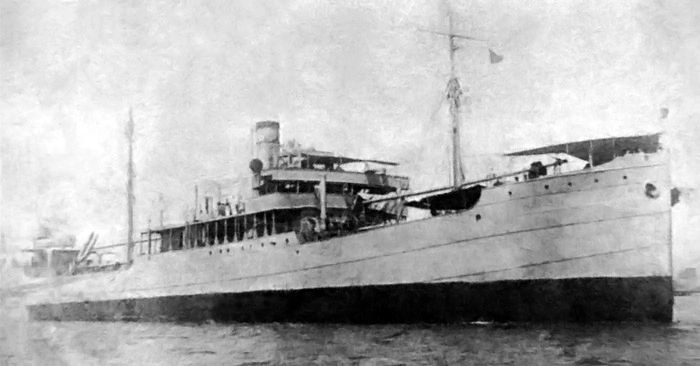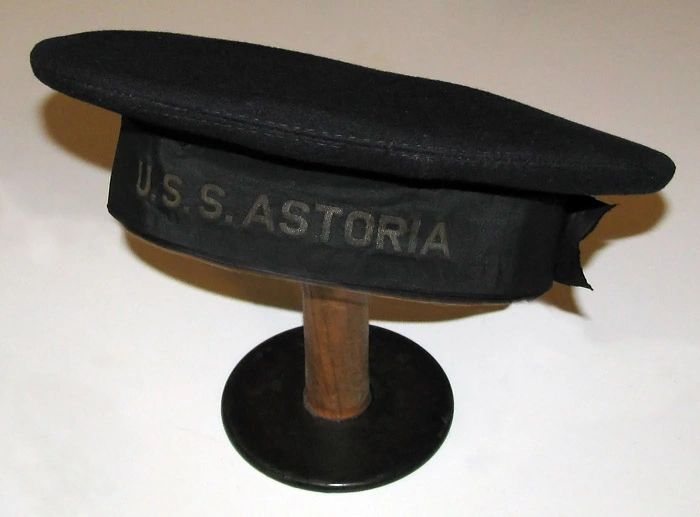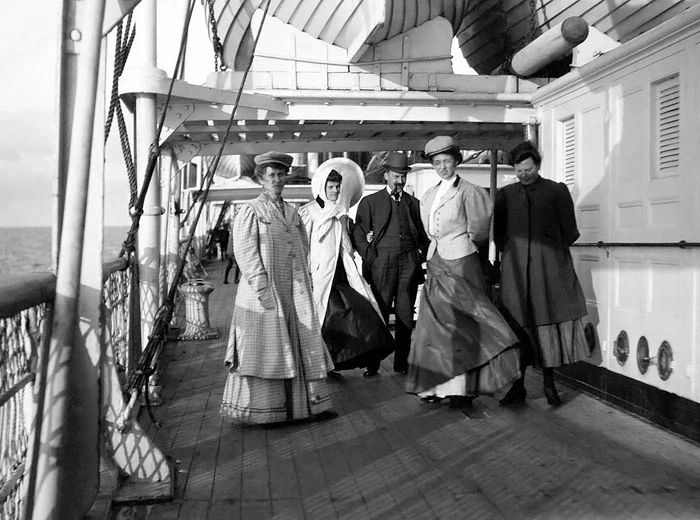USS ASTORIA CA-34
The Official Home of 'Nasty Asty'
USS ASTORIA AK-8

CLICK PHOTO TO ENLARGE
USS ASTORIA AK-8 circa 1919.
-photo from Columbia River Maritime Museum collection, Brent Jones restoration
From the Dictionary of American Naval Fighting Ships:
The first ASTORIA [sic]—a steel-hulled, coal burning steam cargoman constructed in 1902 at Sunderland, England, by J. Blumer & Co. as SS BURBO BANK for the Fenwick Shipping Co., Ltd.—was acquired by Leonhardt & Blumberg of Hamburg, Germany, shortly before the beginning of World War I and was renamed SS FRIEDA LEONHARDT.
After the outbreak of hostilities, she took refuge in
Assigned to the Naval Overseas Transportation Service,

A Great War-era American sailor's hat from USS ASTORIA AK-8 circa 1918. This is the oldest artifact in my USS ASTORIA collection.
-Brent Jones collection
On 10 May, the ship was assigned duty as a coal carrier for the Army. In that capacity, she shuttled between
Upon her return, she resumed cargo-carrying operations out of

CLICK PHOTO TO ENLARGE
USS ASTORIA AK-8 during on of her two transits of the Panama Canal, either January or November 1920. During her service with the Pacific Fleet, ASTORIA received her two-letter AK-8 designation.
-photo from Brent Jones Collection
On 11 November [1920], the ship headed back toward the east coast.

CLICK PHOTO TO ENLARGE
Passengers aboard the newly-decommissioned ASTORIA circa 1921.
-photo from Brent Jones Collection
USS ASTORIA AK-8 Specifications:
Displacement: 7150 tons
Length: 319 ft 7 in
Beam: 46 ft (waterline)
Draft: 20 ft 1 in (mean)
Speed: 9.5 knots
Complement: 131 officers and men
Armament: four 3" guns, two MG

History of USS ASTORIA AK-8 as written in the ASTORIA CL-90 commissioning program, 17 May 1944.
-courtesy Jim Peddie

BACK TO USS ASTORIA LEGACY
Sources
Jones,Brent. Private photo, document and artifact collection.
Mooney, James L., ed. Dictionary of American Naval Fighting Ships, 8 Vols.
Peddie, Jim. Private document collection.

CLICK PHOTO TO ENLARGE
USS ASTORIA AK-8 circa 1919.
-photo from Columbia River Maritime Museum collection, Brent Jones restoration
From the Dictionary of American Naval Fighting Ships:
The first ASTORIA [sic]—a steel-hulled, coal burning steam cargoman constructed in 1902 at Sunderland, England, by J. Blumer & Co. as SS BURBO BANK for the Fenwick Shipping Co., Ltd.—was acquired by Leonhardt & Blumberg of Hamburg, Germany, shortly before the beginning of World War I and was renamed SS FRIEDA LEONHARDT.
After the outbreak of hostilities, she took refuge in
Assigned to the Naval Overseas Transportation Service,

A Great War-era American sailor's hat from USS ASTORIA AK-8 circa 1918. This is the oldest artifact in my USS ASTORIA collection.
-Brent Jones collection
On 10 May, the ship was assigned duty as a coal carrier for the Army. In that capacity, she shuttled between
Upon her return, she resumed cargo-carrying operations out of

CLICK PHOTO TO ENLARGE
USS ASTORIA AK-8 during on of her two transits of the Panama Canal, either January or November 1920. During her service with the Pacific Fleet, ASTORIA received her two-letter AK-8 designation.
-photo from Brent Jones Collection
On 11 November [1920], the ship headed back toward the east coast.

CLICK PHOTO TO ENLARGE
Passengers aboard the newly-decommissioned ASTORIA circa 1921.
-photo from Brent Jones Collection
USS ASTORIA AK-8 Specifications:
Displacement: 7150 tons
Length: 319 ft 7 in
Beam: 46 ft (waterline)
Draft: 20 ft 1 in (mean)
Speed: 9.5 knots
Complement: 131 officers and men
Armament: four 3" guns, two MG

History of USS ASTORIA AK-8 as written in the ASTORIA CL-90 commissioning program, 17 May 1944.
-courtesy Jim Peddie

BACK TO USS ASTORIA LEGACY
Sources
Jones,Brent. Private photo, document and artifact collection.
Mooney, James L., ed. Dictionary of American Naval Fighting Ships, 8 Vols.
Peddie, Jim. Private document collection.
